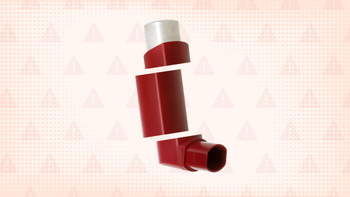Symbicort
Symbicort (budesonide / formoterol) is a combination inhaler used to treat asthma and chronic obstructive pulmonary disease (COPD). It contains two medications: budesonide, a steroid, and formoterol, a long-acting beta-agonist (LABA). Both medications work together to reduce inflammation in the lungs and open up your airways. The typical dose is two puffs by mouth twice a day, usually about 12 hours apart. Common side effects include common cold symptoms, headache, and sore throat.

What is Symbicort (budesonide / formoterol)?
What is Symbicort (budesonide / formoterol) used for?
Asthma - in adults and children 6 years and older
Chronic obstructive pulmonary disease (COPD) - in adults
How Symbicort (budesonide / formoterol) works
Symbicort (budesonide / formoterol) is a combination of two medications.
Budesonide is a corticosteroid. It works by lowering swelling and irritation in your lungs. This helps make breathing easier.
Formoterol is a long-acting beta-agonist (LABA). It relaxes the muscles in your airways. This opens up the lungs, helping air flow more easily.
Drug Facts
More on Symbicort (budesonide / formoterol) essentials

Get your GoodRx coupon

What are the side effects of Symbicort (budesonide / formoterol)?
Common Side Effects
- Common cold symptoms (10-11%)
- Upper respiratory tract infection (8-11%)
- Headache (7-11%)
- Sore throat (6-9%)
- Sinus infection (5-6%)
- Common cold symptoms (7%)
- Oral thrush (6%)
- Bronchitis (5%)
Other Side Effects
- Flu symptoms
- Back pain
- Nasal congestion
- Stomach discomfort
- Vomiting
- Oral thrush
- Sinus infection
- Upper respiratory tract infection
Serious Side Effects
- Sudden narrowing of the airways: worsening trouble breathing, coughing, wheezing
- Severe allergic reaction: rash, hives, swelling of the face or tongue, breathing problems
- Overdose: chest pain, a fast or irregular heartbeat, tremor, headache, nervousness
- Pneumonia: more mucus, fever, more coughing, mucus that changes color, chills, more trouble breathing
- Other infections: fever, body aches, tiredness, vomiting, pain, chills, nausea
Source: DailyMed
More on Symbicort (budesonide / formoterol) side effects
The following side effects have also been reported
Along with its needed effects, a medicine may cause some unwanted effects. Although not all of these side effects may occur, if they do occur they may need medical attention.
Check with your doctor immediately if any of the following side effects occur:
More common
Body aches or pain
chills
difficulty with breathing
ear congestion
headache
loss of voice
muscle aches
pain or tenderness around the eyes and cheekbones
stuffy or runny nose
tightness of the chest
unusual tiredness or weakness
Less common
Bladder pain
bloody or cloudy urine
congestion
cough producing mucus
difficult, burning, or painful urination
dryness of the throat
fast, irregular, pounding, or racing heartbeat or pulse
frequent urge to urinate
general feeling of discomfort or illness
hoarseness
joint pain
loss of appetite
lower back or side pain
noisy breathing
shakiness in the legs, arms, hands, or feet
shivering
sore mouth or tongue
stomach pain
sweating
tender, swollen glands in the neck
trembling or shaking of the hands or feet
trouble with sleeping
trouble with swallowing
voice changes
vomiting
white patches in the mouth or on the tongue
Rare
Blurred vision
confusion
decreased urine
dizziness or lightheadedness when getting up suddenly from a lying or sitting position
enlarged pupils
fainting
flushed, dry skin
fruit-like breath odor
increased hunger
increased sensitivity of the eyes to light
increased sweating, possibly with fever or cold, clammy skin
increased thirst
increased urination
large, hive-like swelling on the face, eyelids, lips, tongue, throat, hands, legs, feet, or sex organs
muscle cramps
nervousness
numbness or tingling in the hands, feet, or lips
pounding in the ears
seizures
severe chest pain
severe headache
slow, fast, pounding, or irregular heartbeat or pulse
stiff or sore neck
unexplained weight loss
Incidence not known
Blindness
decreased vision
puffiness or swelling of the eyelids or around the eyes, face, lips or tongue
tearing
Get emergency help immediately if any of the following symptoms of overdose occur:
Symptoms of overdose
Arm, back, or jaw pain
chest pain or discomfort
darkening of the skin
drowsiness
mental depression
rapid, deep breathing
restlessness
skin rash
stomach cramps
Some side effects may occur that usually do not need medical attention. These side effects may go away during treatment as your body adjusts to the medicine. Also, your health care professional may be able to tell you about ways to prevent or reduce some of these side effects. Check with your health care professional if any of the following side effects continue or are bothersome or if you have any questions about them:
More common
Stomach discomfort
Less common
Belching
difficulty with moving
indigestion
muscle spasms or stiffness
pain in the arms or legs
stomach upset
swollen joints
Other side effects not listed may also occur in some patients. If you notice any other effects, check with your healthcare professional.
Call your doctor for medical advice about side effects. You may report side effects to the FDA at 1-800-FDA-1088.

Pros and cons of Symbicort (budesonide / formoterol)

Pros
Long-term treatment for both COPD and asthma
Might feel relief in as soon as 15 minutes for asthma
Safe for children 6 years and older for asthma
Combines two medications into one inhaler for convenience

Cons
Won't work well for asthma attacks or COPD flare ups
Can cause thrush in mouth or throat as a side effect
Taken 2 times a day
Possible bone loss if used for a long time

Pharmacist tips for Symbicort (budesonide / formoterol)

Take Symbicort (budesonide / formoterol) every day, 2 puffs in the morning and 2 puffs in the evening. Try to take the doses about 12 hours apart to keep the medication working all day.
If you miss a dose of Symbicort (budesonide / formoterol), just take your next dose at your usual time. Don’t take extra puffs to make up for the missed dose.
Symbicort (budesonide / formoterol) isn't used to treat symptoms of an asthma attack or a COPD flare up. or sudden asthma attacks or COPD flare-ups. If you have wheezing, coughing, shortness of breath, or chest tightness, tell your doctor right away. Always keep a rescue inhaler like albuterol with you for emergencies.
Get your routine tests done on time while you're taking Symbicort (budesonide / formoterol). These checkups help your prescriber see if the medication is working and not causing problems. Tests might include blood work, breathing tests, and eye exams.
Talk to your prescriber or pharmacist before starting any new medications. Some medications can interact with Symbicort (budesonide / formoterol) and cause more side effects.
Write use-by date: Once you open the foil pouch, write down the use-by date on the inhaler (3 months from the day you opened it). Throw away the inhaler when it hits 3 months or shows “0” doses, whichever comes first.
Priming the inhaler: If you're using a new inhaler, haven't used it in over a week, or if you drop it, you'll need to "prime" it. This means shaking it and then spraying 2 puffs into the air. Priming makes sure you get the right dose when you use it.
Taking a dose: Shake the inhaler, breathe out fully, and place the mouthpiece in your mouth. Inhale deeply while spraying 1 puff, then hold your breath for up to 10 seconds. Repeat for the second puff.
After use: Rinse your mouth with water and spit it out. This helps prevent a yeast infection called oral thrush). Call your prescriber if you notice white patches in your mouth or throat.
Cleaning: Wipe the mouthpiece with a dry cloth once a week so the medication doesn't build up and block the spray through the mouthpiece. Don't rinse the inhaler with water.
More on Symbicort (budesonide / formoterol) tips

Frequently asked questions about Symbicort (budesonide / formoterol)

How to save using GoodRx




What are the risks and warnings for Symbicort (budesonide / formoterol)?
Symbicort (budesonide / formoterol) can cause some serious health issues. This risk may be even higher for certain groups. If this worries you, talk to your doctor or pharmacist about other options.

Worsening asthma or COPD
Risk factors: Using albuterol more often | Using too much Symbicort (budesonide / formoterol)
Symbicort (budesonide / formoterol) shouldn't be used for asthma attacks or serious breathing problems from asthma or COPD. If you suddenly have trouble breathing or start wheezing, use a rescue inhaler like albuterol instead.
If you notice you're using your rescue inhaler more often, tell your prescriber right away. This could mean your condition is getting worse and your treatment might need to change. Don't take more than 2 puffs in the morning and 2 puffs in the evening.

Overdose
Risk factors: Using too much Symbicort (budesonide / formoterol) | Using together with other LABAs
Using Symbicort (budesonide / formoterol) more often, at a higher dose than prescribed, or with another LABA can raise your risk of overdose. Taking too much can lead to serious side effects like heart problems, and in rare cases, even death. Get medical help right away if you have symptoms like chest pain, a fast or irregular heartbeat, tremor, headache, or nervousness.

Oral thrush
Risk factor: Not rinsing and spitting after using Symbicort (budesonide / formoterol)
Symbicort (budesonide / formoterol) can sometimes cause a yeast infection in your mouth or throat called oral thrush. Symptoms include white patches inside of your mouth, redness, soreness, or pain while eating or swallowing. If you notice these symptoms, tell your prescriber right away since you might need an antifungal medication to treat it. To help prevent this, rinse your mouth with water after each use and spit it out — don’t swallow the water.

Pneumonia
Risk factors: COPD
Symbicort (budesonide / formoterol) can raise your risk of certain lung infections like pneumonia, especially if you have COPD. Keep in mind that pneumonia can look a lot like a COPD flare up, so tell your prescriber if you have more mucus, a fever, more coughing, mucus that changes color, chills, or more trouble breathing. They can help figure out the cause and choose the right treatment for you.

Higher risk of infection
Risk factors: Active, chronic (long-term), or recurrent infection | Medical conditions that weaken the immune system | Taking other medications that can weaken the immune system
Symbicort (budesonide / formoterol) can make it harder for your body to fight infections. Infections like tuberculosis, chickenpox, and measles can be more serious if you're using this medication. Don't use Symbicort (budesonide / formoterol) if you have an active or ongoing infection without talking with your prescriber first. Let them know right away if you have signs of an infection, such as a fever, body aches, tiredness, vomiting, pain, chills, or nausea.

Changes in stress hormone levels
Risk factors: High doses of Symbicort (budesonide / formoterol) | Using Symbicort (budesonide / formoterol) for a long time | Stressful events (e.g., surgery)
Rarely, using an inhaled steroid like Symbicort (budesonide / formoterol) for a long time can lead to adrenal insufficiency, a condition where your body doesn't make enough of its own steroid hormones. To help prevent this, your prescriber will recommend the lowest dose of Symbicort (budesonide / formoterol) that works for you, for the shortest amount of time. If you need to use the medication long term, your prescriber might order some lab tests to check how well your adrenal glands are working. Let your prescriber know if you feel very tired, weak, or sick to your stomach — especially after surgery or during times of stress — as these could be signs of low steroid levels.

Sudden narrowing of the airways
Although rare, Symbicort (budesonide / formoterol) can cause paradoxical bronchospasm, which means your breathing suddenly gets worse right after using the inhaler. This can be life-threatening if not treated quickly. If you notice more wheezing, shortness of breath, or coughing after using Symbicort (budesonide / formoterol), stop using it and use a rescue inhaler (like albuterol) right away. Contact your prescriber since you might need to switch to a different treatment.

Serious allergic reaction
Some people might have an allergic reaction immediately after using Symbicort (budesonide / formoterol). This could include hives, swelling of the face or throat, rash, or trouble breathing. If you notice any of these signs, stop using the inhaler and get medical help right away.

Heart and nervous system problems
Risk factors: History of heart problems | Using too much Symbicort (budesonide / formoterol)
Using too much Symbicort (budesonide / formoterol) can lead to serious issues like seizures, heart problems, and changes in blood pressure. To stay safe, only use it exactly as your prescriber tells you. Talk to your prescriber right away if you experience chest pain, fast heart rate, headache, tremor, nausea, dizziness, and trouble sleeping.

Risk of bone loss
Risk factors: Using Symbicort (budesonide / formoterol) long term | Older adult | Unable to move for a long period of time | Family history of osteoporosis | Poor diet | Postmenopausal | Smoking | Using medications that can cause bone loss
People taking Symbicort (budesonide / formoterol) for a long time might be at risk for bone loss. It's not clear if this leads to broken bones, but the risk is higher if you're an older adult, postmenopausal, have a poor diet, smoke, or take certain medications. Your prescriber might check your bone density regularly to make sure your bones stay healthy. If you've had broken bones or have a history of osteoporosis, talk to your prescriber before starting this medication.

Poor growth
Risk factors: Children
Inhaled corticosteroids like Symbicort (budesonide / formoterol) can slow down growth in children. If your child is using this medication, their height should be checked regularly to make sure they're growing normally. To lower the risk of side effects, your child's prescriber will try to use the lowest dose of Symbicort (budesonide / formoterol) that still works well to control symptoms.

Eye problems
Risk factors: Long-term use of Symbicort (budesonide / formoterol) | History of eye problems like glaucoma or cataracts | Higher dose of Symbicort (budesonide / formoterol)
Using Symbicort (budesonide / formoterol) for a long time can raise eye pressure, worsen glaucoma, or lead to cataracts. Talk to your prescriber right away if you experience blurry vision, eye discomfort, or other changes in your vision. You might need an eye exam to check for these problems.

Low potassium and high blood sugar
Symbicort (budesonide / formoterol) can sometimes cause low potassium levels, which can affect your heart rhythm. This is usually temporary and doesn’t need treatment. Let your care team know if you have muscle pain or weakness, muscle cramps, or abnormal heartbeat as these can be signs of low potassium.
In rare cases, Symbicort (budesonide / formoterol) can also raise blood sugar levels. Let your prescriber know if you're feeling more thirsty or hungry than usual, confused, or urinating more often. These can be signs of high blood sugar.

Symbicort (budesonide / formoterol) dosage forms
Typical dosing for Symbicort (budesonide / formoterol)
Symbicort (budesonide / formoterol) comes in two different strengths:
Symbicort 80/4.5 - each puff has 80 mcg of budesonide and 4.5 mcg of formoterol
Symbicort 160/4.5 - each puff has 160 mcg of budesonide and 4.5 mcg of formoterol.
Asthma
Adults and children 12 years and older: The typical dose is two puffs of Symbicort 80/4.5 OR Symbicort 160/4.5 by mouth twice a day, 12 hours apart.
Children 6 to 11 years old: The typical dose is two puffs of Symbicort 80/4.5 by mouth twice a day, 12 hours apart.
COPD
Adults: The typical dose is two puffs of Symbicort 160/4.5 by mouth twice a day, 12 hours apart.
More on Symbicort (budesonide / formoterol) dosage forms

Interactions between Symbicort (budesonide / formoterol) and other drugs
Using this medicine with any of the following medicines is not recommended. Your doctor may decide not to treat you with this medication or change some of the other medicines you take.
- Bepridil
- Cisapride
- Desmopressin
- Dronedarone
- Mesoridazine
- Pimozide
- Piperaquine
- Saquinavir
- Sparfloxacin
- Terfenadine
- Thioridazine
- Ziprasidone
Using this medicine with any of the following medicines is usually not recommended, but may be required in some cases. If both medicines are prescribed together, your doctor may change the dose or how often you use one or both of the medicines.
- Acebutolol
- Aceclofenac
- Acemetacin
- Alfuzosin
- Amiodarone
- Amisulpride
- Amtolmetin Guacil
- Anagrelide
- Apomorphine
- Aripiprazole
- Aripiprazole Lauroxil
- Arotinolol
- Arsenic Trioxide
- Asenapine
- Astemizole
- Atazanavir
- Atenolol
- Azithromycin
- Balofloxacin
- Bedaquiline
- Befunolol
- Bemiparin
- Besifloxacin
- Betaxolol
- Bevantolol
- Bisoprolol
- Boceprevir
- Bopindolol
- Bromfenac
- Bucindolol
- Bufexamac
- Bupranolol
- Buprenorphine
- Bupropion
- Buserelin
- Carteolol
- Carvedilol
- Celecoxib
- Celiprolol
- Ceritinib
- Chloroquine
- Chlorpromazine
- Choline Salicylate
- Ciprofloxacin
- Citalopram
- Clarithromycin
- Clofazimine
- Clonixin
- Clozapine
- Cobicistat
- Conivaptan
- Crizotinib
- Cyclobenzaprine
- Dabrafenib
- Darunavir
- Dasatinib
- Degarelix
- Delamanid
- Deslorelin
- Deutetrabenazine
- Dexibuprofen
- Dexketoprofen
- Diclofenac
- Diflunisal
- Dilevalol
- Dipyrone
- Disopyramide
- Dofetilide
- Dolasetron
- Domperidone
- Donepezil
- Droperidol
- Droxicam
- Duvelisib
- Ebastine
- Efavirenz
- Encorafenib
- Enoxacin
- Entrectinib
- Eribulin
- Erythromycin
- Escitalopram
- Esmolol
- Etodolac
- Etofenamate
- Etoricoxib
- Famotidine
- Felbamate
- Felbinac
- Fenoprofen
- Fepradinol
- Feprazone
- Fingolimod
- Flecainide
- Fleroxacin
- Floctafenine
- Fluconazole
- Flufenamic Acid
- Flumequine
- Fluoxetine
- Flurbiprofen
- Foscarnet
- Fosnetupitant
- Fosphenytoin
- Fostemsavir
- Galantamine
- Gatifloxacin
- Gemifloxacin
- Glasdegib
- Gonadorelin
- Goserelin
- Granisetron
- Halofantrine
- Haloperidol
- Histrelin
- Hydroquinidine
- Hydroxychloroquine
- Hydroxyzine
- Ibuprofen
- Ibutilide
- Idelalisib
- Iloperidone
- Indomethacin
- Inotuzumab Ozogamicin
- Itraconazole
- Ivabradine
- Ivosidenib
- Ketoconazole
- Ketoprofen
- Ketorolac
- Labetalol
- Landiolol
- Lapatinib
- Larotrectinib
- Lefamulin
- Lenvatinib
- Leuprolide
- Levobunolol
- Levofloxacin
- Lofexidine
- Lomefloxacin
- Lorlatinib
- Lornoxicam
- Loxoprofen
- Lumacaftor
- Lumefantrine
- Lumiracoxib
- Lutetium Lu 177 Dotatate
- Macimorelin
- Meclofenamate
- Mefenamic Acid
- Mefloquine
- Meloxicam
- Mepindolol
- Methacholine
- Methadone
- Methotrimeprazine
- Metipranolol
- Metoprolol
- Metronidazole
- Mifepristone
- Mirtazapine
- Mizolastine
- Moricizine
- Morniflumate
- Moxifloxacin
- Nabumetone
- Nadifloxacin
- Nadolol
- Nadroparin
- Nafarelin
- Naproxen
- Nebivolol
- Nelfinavir
- Nepafenac
- Netupitant
- Niflumic Acid
- Nilotinib
- Nimesulide
- Nimesulide Beta Cyclodextrin
- Norfloxacin
- Octreotide
- Ofloxacin
- Olanzapine
- Ondansetron
- Osilodrostat
- Osimertinib
- Oxaliplatin
- Oxaprozin
- Oxprenolol
- Oxyphenbutazone
- Ozanimod
- Paliperidone
- Panobinostat
- Papaverine
- Parecoxib
- Paroxetine
- Pasireotide
- Pazopanib
- Pazufloxacin
- Pefloxacin
- Penbutolol
- Pentamidine
- Perphenazine
- Phenylbutazone
- Piketoprofen
- Pimavanserin
- Pindolol
- Pipamperone
- Piroxicam
- Pitolisant
- Ponesimod
- Posaconazole
- Practolol
- Pranoprofen
- Probucol
- Procainamide
- Prochlorperazine
- Proglumetacin
- Promethazine
- Propafenone
- Propranolol
- Propyphenazone
- Proquazone
- Prulifloxacin
- Quetiapine
- Quinidine
- Quinine
- Ranolazine
- Ribociclib
- Risperidone
- Ritonavir
- Rofecoxib
- Rufloxacin
- Salicylic Acid
- Salsalate
- Sargramostim
- Selpercatinib
- Sertindole
- Sertraline
- Siponimod
- Sodium Phosphate
- Sodium Phosphate, Dibasic
- Sodium Phosphate, Monobasic
- Sodium Salicylate
- Solifenacin
- Sorafenib
- Sotalol
- Sparfloxacin
- Sulindac
- Sulpiride
- Sultopride
- Sunitinib
- Tacrolimus
- Talinolol
- Tamoxifen
- Telaprevir
- Telavancin
- Telithromycin
- Tenoxicam
- Tertatolol
- Tetrabenazine
- Tiaprofenic Acid
- Timolol
- Tolfenamic Acid
- Tolmetin
- Tolterodine
- Toremifene
- Tosufloxacin
- Trazodone
- Triclabendazole
- Triptorelin
- Valdecoxib
- Vandetanib
- Vardenafil
- Vemurafenib
- Venlafaxine
- Vilanterol
- Vinflunine
- Voclosporin
- Voriconazole
- Vorinostat
- Zotepine
- Zuclopenthixol
Using this medicine with any of the following medicines may cause an increased risk of certain side effects, but using both drugs may be the best treatment for you. If both medicines are prescribed together, your doctor may change the dose or how often you use one or both of the medicines.
- Auranofin
- Erythromycin
- Ketoconazole

How much does Symbicort (budesonide / formoterol) cost?

Symbicort (budesonide / formoterol) contraindications
Asthma attacks
Severe episodes of asthma or COPD

What are alternatives to Symbicort (budesonide / formoterol)?
Asthma - in adults and children 6 years and older
Chronic obstructive pulmonary disease (COPD) - in adults
Maintenance treatment of asthma in people ages 5 years and older

What is the latest news about Symbicort (budesonide / formoterol)?

Symbicort (budesonide / formoterol) images
Get savings updates for Symbicort (budesonide / formoterol)
Receive price alerts, news, and other messages from GoodRx about Symbicort (budesonide / formoterol) and other healthcare topics and relevant savings offers.By providing your email, you consent to receive marketing communications from GoodRx, which may include content and/or data related to men’s health, women's health, reproductive care, or sexual health. You agree to the GoodRx Terms of Use and acknowledge the Privacy Policy. You can unsubscribe at any time.
References
Best studies we foundAstraZeneca Pharmaceuticals LP. (2019). SYMBICORT- budesonide and formoterol fumarate dihydrate aerosol [package insert]. DailyMed.
Magee, J. S., et al. (2018). Paradoxical bronchoconstriction with short-acting beta agonist. American Journal of Case Reports.
Compare other Asthma, COPD drugs
Browse medications
View AllResearch prescriptions and over-the-counter medications from A to Z, compare drug prices, and start saving.


















